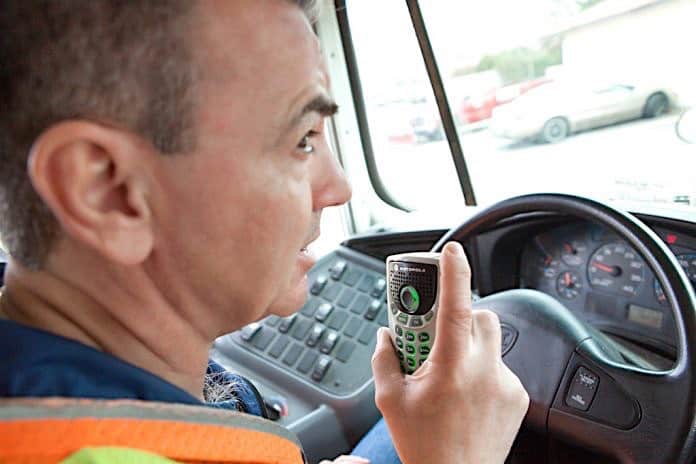With driver distraction concerns, driver communication has become more challenging. As reported in STN, a 2014 school bus crash in Tennessee was linked to bus driver texting. According to National Highway Traffic Safety Administration statistics, texting increases the likelihood of a crash by a factor of 23. Not 23 percent. These drivers are 23 times more likely to be involved in a safety-critical event. Although odds are much lower for a crash when using mobile phone for a call, statistics show the risk is still increased by a factor of six.
While the focus has been on distracted driving, it is important to consider other factors as they relate to driver communications. An example is the following scenario that happened recently in Virginia:
A school bus breaks down. The driver is unable to reach anyone due to an unreliable radio system. As a result, the driver leaves the bus to find a phone so dispatch can send another bus from the garage. Fortunately, in this instance, the driver happened to have an aide on the bus who supervised the children. The breakdown wasn’t an emergency, but until the school district replaces its radio system, the potential is there for a repeat occurrence.
Sound familiar? It may not have happened to you but it could if your means of communicating with drivers is unreliable, broken or possibly non-compliant with new regulations.
Tremendous technological strides have resulted in transportation directors having more information on the status of their vehicles that go beyond simply location. The power of GPS is much more than that. These capabilities include integration with routing software that improves route efficiency by comparing planned versus actual routing, systems that track and monitor student ridership, sensors that detect and record stop-arm events, even cameras that record violations. In the coming years you will see technologies like automatic speeding detection devices, systems that avoid forward collisions, detect and warn of lane departures and control vehicle stability, technology that is available in new passenger vehicles today.
However, if something out of the ordinary happens, there is still a need to be able to speak with the driver. In the past, many districts have deployed cell phones for driver communications. But driver distraction concerns have made cell phones a non-viable option due to increased legislation restricting the use of cell phones while driving. Although no state bans all cell phone use by drivers, 20 states and the District of Columbia ban the use of cell phones by school bus drivers while driving and if children are present. The trend is for an increase in a number of states enacting similar legislation.
So, what to do? Traditionally, districts have used two-way radio systems for driver communications. The advantage of two-way radio is that these systems fall outside the scope of the FMSCA regulations (FCC 47 CFR 20.3) limiting mobile telephones while driving. While proper usage of two-way radios is still required – “No Reaching, No Holding, No Dialing” – two-way radios are not prohibited.
 Bruce M. LeeUnfortunately, many older, analog systems are increasingly unreliable or are broken and require replacement. The cost of repairing or replacing these systems can be cost-prohibitive, especially if the district owns the system, (often a “hand-me-down” from a public safety agency). Budgeting for these capital expenses is difficult and often impossible.
Bruce M. LeeUnfortunately, many older, analog systems are increasingly unreliable or are broken and require replacement. The cost of repairing or replacing these systems can be cost-prohibitive, especially if the district owns the system, (often a “hand-me-down” from a public safety agency). Budgeting for these capital expenses is difficult and often impossible.
Assuming two-way radio makes sense, the options are to: (a) build and own a system, or (b) use a system by a local provider. Increasingly, there is a preference for working with a local two-way provider that has an understanding of your local market and your requirements. These new two-way radio systems employ the latest digital technology that overcome many of the performance shortcomings of older, analog systems, especially in terms of coverage and reliability.
It is important to explore a number of network options that can provide the performance you need. In doing so, you will find solutions that not only address your driver communications needs but are compliant with distracted driving regulations. And, you don’t have to own the system.
Bruce M. Lee is product manager at pdvWireless, a provider of Motorola MOTOTRBO fleet and employee communications solutions.
















